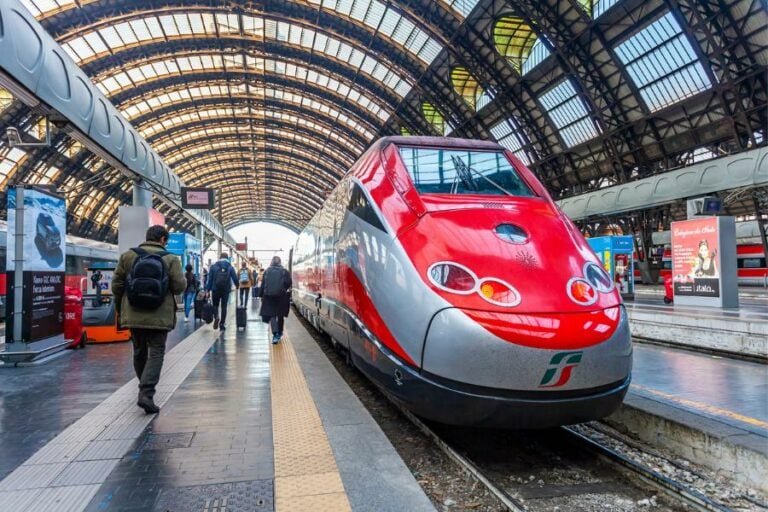Top 15 Rivers of Italy: The Lifelines of the Landscape

This list explores the majestic rivers of Italy, tracing the lifelines that have shaped the nation’s landscape and history. Each river tells a story, weaving through cities and countryside to reveal secrets of Italy’s past and present.
Overview Of The Rivers Of Italy
Italy’s geography is markedly dominated by the presence of rivers that traverse its diverse landscapes, flowing from the Alps in the north to the Apennines, which run like a spine down the length of the country. These waterways have been crucial to Italian history, culture, and development.
In the north, the Po River is the longest river in Italy, playing a pivotal role in the region’s agricultural and economic framework. Rising from the Alpine slopes, it traverses the fertile Po Valley through cities like Piacenza and Ferrara, eventually emptying into the Adriatic Sea.
The northern waterways, such as those in Lombardy, Liguria, and Veneto, are integral to the industries and agriculture of these regions.
The rugged Apennine mountains, Italy’s central spine, give rise to numerous rivers, including the Arno, which flows through Florence and Pisa, and the Tiber, the lifeblood of Rome. Many of these rivers empty into the Tyrrhenian Sea, shaping the landscapes of Tuscany, Lazio, and Campania.
Despite their shorter lengths, Italy’s island rivers, such as the Coghinas, are vital to regions like Sardinia. They support agriculture, tourism, and energy production.
| Main Regions | Rivers |
|---|---|
| Piedmont, Lombardy, Emilia-Romagna, Veneto | Po River |
| Umbria, Lazio | Tiber River |
| Tuscany, Emilia-Romagna | Arno River |
| Trentino-Alto Adige, Veneto | Adige River |
| Piedmont, Lombardy | Ticino River |
| Lombardy | Adda River |
| Trentino-Alto Adige, Veneto | Brenta River |
| Lombardy | Oglio River |
| Piedmont | Tanaro River |
| Veneto | Piave River |
| Emilia-Romagna, Tuscany | Reno River |
| Emilia-Romagna | Savio River |
| Sicily | Alcantara River |
| Sardinia | Coghinas River |
| Sicily | Belice River |
Italian rivers also play a significant role in the connectivity and transportation networks. From the Venetian lagoons, where waterways act as streets, to the outskirts of Milan, rivers have historically paved the way for trade and communication.
1. Po River
The Po River is significant in Italy as the country’s longest river. Starting from the Monte Viso group of the Cottian Alps, the river’s journey spans 405 miles (652 km) before it culminates in emptying into the Adriatic Sea.
Course
It begins in the Piedmont region and flows east through Lombardy and the expansive Po Valley, which it nourishes and is known for its fertility. This valley is paramount to Italy’s agriculture sector due to the rich sediment deposited by the river.
The Po continues its path through the regions of Veneto and Emilia-Romagna, with cities like Ferrara, Piacenza, Verona, and Cremona situated along its banks.
Tributaries
The Po’s network comprises numerous tributaries, enhancing its volume and importance. These branches originate from the Alps and the Apennines, bolstering the river’s influence across Northern Italy.
Po River’s Main Tributaries:
- Ticino
- Adda
- Oglio
- Mincio
Environmental Aspects

While it stands as a lifeline, the Po is also prone to flooding, which can cause significant damage. The river’s lower stretches near the delta are particularly vulnerable to torrential waters, influencing flood management strategies in the region.
Ferrara, a city enriched by Renaissance history and built around a ford of the Po, epitomizes the cultural heritage regions along the river’s path. Meanwhile, conservation efforts aim to preserve the Po’s delta, recognizing the area’s ecological complexity and significance.
2. Tiber River

Rome was founded alongside the Tiber River, the third-longest river in Italy. The river has historical weight and is intimately tied to Rome’s rise and growth.
It originates from the sloping lands of Monte Fumaiolo in the Apennines, marking its journey through central Italy to the Tyrrhenian Sea.
| Length | 252 miles (405 km) |
|---|---|
| Source | Monte Fumaiolo |
| Mouth | Tyrrhenian Sea |
Traversing a southward path, the Tiber River flows through numerous scenic valleys and gorges. As it reaches Rome, its presence has been a defining feature of the city’s landscape and history.
The river’s course through Rome is showcased in Giambattista Nolli’s Pianta Grande of 1748, a testament to its significance (Nolli’s Tiber River).

Rome is not the only city along the Tiber; notably, Perugia also stands at its banks, boasting a rich history. Small steamers can navigate the Tiber from its northern mouth up to Rome, speaking to its navigability at least for parts of its course.
Historically, the river Tiber has had a dual role: sustaining and challenging the city it nurtures. Despite its picturesque flow, the Tiber is no stranger to tumult, as floods have marked Rome’s past.
These events carry historical gravity, recorded as early as 189 BCE when the Tiber overflowed into the Campus Martius (Floods of the Tiber in Ancient Rome).
Though the Tiber is no longer central to trade and commerce or transport as it once was, it remains an enduring symbol of Rome, weaving through Italy’s natural and cultural landscapes.
3. Arno River

The Arno River is a significant waterway in central Italy, with its origins nestled in the Apennines mountains. Flowing from Monte Falterona, the river extends approximately 150 miles (240 kilometers) before reaching the Tyrrhenian Sea near Pisa.
Florence, a renowned cultural and historical city, is graced by the Arno River, adding to its picturesque landscape.
The celebrated Ponte Vecchio, an iconic medieval stone arch bridge over the Arno, is adorned with shops and provides a historic crossing point within the city.
| Characteristic | Detail |
|---|---|
| Source | Apennines |
| Length | 240 km (150 mi) |
| Outlet | Tyrrhenian Sea |
| Regions | Tuscany |
| Major Cities | Florence, Pisa |
The river has been known to cause disaster when it floods, such as the catastrophic flooding of Florence in 1966.
The river’s course supports diverse ecosystems and enriches agricultural lands, contributing to Tuscany’s status as a fertile region.
4. Adige River

Spanning 410 kilometers (255 miles) long, the Adige River stands as Italy’s second-largest river and a crucial watercourse in the country. Its source is the Alps, near Italy’s border with Austria and Switzerland, flowing swiftly through South Tyrol’s verdant landscapes.
- Source: Alpine lakes near Resia Pass.
- Flow through South Tyrol: Past Merano and Bolzano, where it receives the Isarco River’s waters.
After Bolzano, this crucial fluvial artery courses through Trentino-Alto Adige, shaping the region’s middle course, which is popularly known as the Lagarina Valley.
As it voyages southward, the river approaches the city of Trento, before meandering through the Veneto region, enriching the land with its bountiful waters.
- Through Veneto: Past Verona, toward the Adriatic Sea.
The river notably graces the city of Verona in Veneto, bestowing this historic urban center with its picturesque riverbanks. Finally, the Adige River concludes its journey, emptying into the Adriatic Sea.
It leaves behind a legacy as the second-longest river in Italy and a vital source of irrigation, commerce, and cultural heritage in the regions it traverses.
- Confluence: Adriatic Sea.
- Significance: Second-longest river in Italy.
The Adige River is a lifeline for agriculture and industry and a witness to millennia of human history, nurturing settlements and civilizations that have flourished upon its banks.
5. Ticino River

The Ticino River is an essential watercourse in Europe. It originates in the Swiss Alps and traverses two countries, Switzerland and Italy, before joining the Po River. It begins its journey near the Novena Pass at a staggering altitude of approximately 8,000 feet.
Course and Hydrology
In Switzerland, the river flows southeast through the scenic Leventina valley, passing the town of Bellinzona. It then continues into Italy, dramatically aiding in the sustenance of regions like Piedmont and Lombardy. With a total length of 248 kilometers, the Ticino River is praised for its pristine waters and rich biodiversity.
Economic Impact
Throughout its route, the Ticino River fosters a variety of economic activities. It is harnessed for hydroelectric power, supporting industries and homes in both countries. The riverbanks harbor lush vegetation, which provides a haven for agriculture, particularly in the fertile plains of Lombardy.
Environmental Significance
Lombardy’s river contributes significantly to the vast farmlands that produce a considerable portion of Italy’s agricultural output. It also plays a vital role in local ecosystems, with its waters nurturing numerous plant and animal species.
By threading a lifeline through the mountainous Swiss terrain into the vibrant Italian plains, the Ticino River is a cornerstone of life in this diversified European region. Its contribution to both Switzerland and Italy is multifaceted, encompassing ecological, cultural, and economic dimensions.
6. Adda River

The Adda River, which originates from the Rhaetian Alps at an elevation of 7,660 feet, is a notable watercourse in the Lombardy region of northern Italy.
This river plays a significant role in the area’s hydrography as it traverses through the picturesque Valtellina valley, providing both scenic beauty and a source of water.
- Length: 313 km (194 miles).
- Source: Rhaetian Alps.
- Outflow: Lake Como, Po River.
The Adda‘s journey begins from the Alps and continues southward toward Bormio and Tirano. Marking its course, it turns westward near Sondrio, enhancing the region’s agricultural productivity.
Eventually, it flows into Lake Como near its northern tip, contributing to the lake’s ecosystem before making its way further to join the Po River.

Lombardy’s Adda River is a natural spectacle and an essential component of the local economy. Its waters are harnessed for hydroelectric power, which is pivotal for the region, making it an important asset in the local infrastructure.
Adda’s River Primary uses:
- Hydroelectric power generation.
- Irrigation for agriculture.
- Recreational activities.
The Adda River’s course is lined with numerous historical sites, and the river itself is a vital lifeline that threads through the terrain of Lombardy. It holds a central place in the region’s ecology and economy, perfectly embodying the intricate bond between nature and human development in this part of Italy.
7. Brenta River

The Brenta River flows gracefully through the Veneto region of Italy. It originates from the Alps and winds its way towards the Adriatic Sea. Historically, the Brenta was a tributary of the Po River, but natural events and human interventions redirected its course to the Adriatic Sea.
| Feature | Detail |
|---|---|
| Source | Italian Alps |
| Length | Approximately 174 km |
| Region | Veneto |
| Outflow | Adriatic Sea |
| Typical activities | Boating, Fishing, Sightseeing |
It is nourished by melting snow and ice from the Alps, ensuring a consistent flow throughout most of the year. The river passes through scenic valleys, flanked by lush greenery and historic towns, presenting an image of quintessential Italian charm.
In its mid-course, the Brenta River garners attention for its engineering feat, the Brenta Canal, which was constructed to facilitate the transport of goods and people between Venice and Padua. This connection underscores the river’s importance to regional commerce and its role in the rich cultural exchange within Italy.
One of the river’s most remarkable aspects is its contribution to biodiversity. Its banks harbor a wide array of wildlife, making it a key ecological corridor in the Veneto plain.
The Brenta River is a natural resource and an integral part of Veneto’s cultural landscape. It offers recreational activities such as boating and fishing. Locals and visitors alike embrace it, drawn to its serene surroundings and aquatic allure.
Suggested Read: 175 Italian Boat Names: Unique, Funny & Cool Ideas
8. Oglio River

The Oglio River is a significant watercourse in Italy. Rising from the Alpine region, it is known as a tributary of the Po River. Originating in the Lombardy region, it plays a crucial role in the country’s intricate fluvial system.
The Oglio begins its journey in the Alps, flowing through Val Camonica, a picturesque valley characterized by its depth and width. Here, the river’s presence is both a geographic and cultural hallmark, winding its way through the verdant landscapes of northern Italy.
The river takes in waters from Lake Iseo, a beautiful alpine lake that enters near Lovere and exits at Sarnico. It nourishes the land and supports both agriculture and local ecosystems before ultimately merging with the mighty Po River, Italy’s longest river and a pivotal channel for commerce and irrigation.
| Characteristic | Information |
|---|---|
| Source | Italian Alps |
| Outflow | Po River |
| Region | Lombardy |
| Cities along the river | Lovere, Sarnico |
| Significance | Irrigation, biodiversity, cultural importance |
Its path underscores the river’s importance to Lombardy’s environment and economy. The Oglio River contributes to the Po River basin, which is integral to the region’s agricultural landscape. This points to a complex interlinkage of bodies of water that bolsters Italian agriculture and settlements along their banks.
9. Tanaro River

The Tanaro River, an important watercourse in Italy, originates from the majestic Alps. It is the principal river of the Piedmont region, which is known for its varied landscapes encompassing mountains, valleys, and rolling plains.
Course and Features
The Tanaro’s journey begins near Mount Saccarello on the Franco-Italian border and flows predominantly northeasterly. The river covers a total length of 276 kilometers before it meets the Po River, Italy’s longest river. Its waters eventually reach the Adriatic Sea, contributing to the rich aquatic life of the region.
Geography and Hydrology
| Attribute | Description |
|---|---|
| Source | Alps (Mount Saccarello) |
| Mouth | Po River |
| Length | 276 km |
| Region | Piedmont |
| Outflow to | Ligurian Sea via Po River |
In its upper course, the Tanaro River cuts through steep valleys, delineating the picturesque landscapes of Piedmont. The river water basin features diverse flora and fauna, adapting to the changing topography from alpine meadows to the more temperate zones downstream.
The Tanaro contributes significantly to the regional economy through activities such as agriculture, which provides irrigation to fertile lands.
However, it also poses challenges, as the river is prone to flash floods, which have shaped its hydrological management strategies to prevent damage to nearby settlements and agricultural areas.
The river’s confluence with the Po River near the province of Alessandria marks an interaction between two critical water networks in Italy, playing a vital role in the drainage system of the northwest Italian plains, and eventual discharge into the Ligurian Sea.
10. Piave River

The Piave River is a prominent northeastern Italy waterway renowned for its historical significance and geographical features. Originating from the slopes of Mount Peralba, the river emerges in the Carnic Alps within the Friuli-Venezia Giulia region, near the Austrian border.
Its journey spans the Veneto region, covering 137 miles (220 km) before culminating in the Adriatic Sea at Cortellazzo.
The river’s upper course carves through the alpine terrain, creating a dramatic landscape before it descends into the Belluno basin. The course transforms here as the Piave weaves through the scenic gorge at Feltre.
Its southeastern flow is then marked by a meandering presence across the Venetian plain. This lower course of the river is characterized by its slow, winding flow through fertile lands which have been an integral part of Italy’s agriculture and viticulture.
The Piave River basin is not merely a geographic feature; it has played a pivotal role in Italian history, especially during World War I, when it became a defining line of defense.
The Battle of Piave River is remembered as a key moment in Italian military history, earning it the title “Fiume Sacro alla Patria” (River Sacred to the Country) in memory of the hard battles fought on its banks.
Today, the Piave River is an essential part of Italy’s hydrogeography, contributing to irrigation and hydroelectric power, and it is a source of water for both industrial and domestic use.
Its banks are also popular for recreational activities, and its waters are rich in biodiversity, supporting various species of fish and other aquatic life.
11. Reno River

The Reno River is a significant waterway in Italy, winding its path through the country’s northern parts. Originating from the Apennine Mountains, this river plays a crucial role in the hydrography of the Emilia-Romagna region.
Course and Features:
- Source: Apennine Mountains.
- Length: Approximately 211 kilometers (131 miles).
- Outflow: Adriatic Sea.
The river emerges from Mount delle Piastre, which is part of the Tuscan-Emilian Apennines. Its journey through Italy’s geography eventually led to its convergence with the Adriatic Sea, enriching the fertile plains of Emilia-Romagna.
The Reno River serves as a vital resource, supplying water for agricultural, industrial, and municipal needs.
Tributaries and Surrounding Regions:
- Primary tributaries include the Setta, Idice, and Sillaro rivers.
- It flows through Bologna, an influential historical and cultural center.

The Reno River’s basin is characterized by its diverse ecology and the plethora of species it supports. The river is closely tied to the community’s livelihoods, with agriculture thriving in its valley.
Despite its importance, the Reno River, like many rivers, faces challenges such as pollution and environmental degradation. Efforts are undertaken to monitor and preserve its conditions, ensuring that it continues to be a lifeline for the Emilia-Romagna region.
12. Savio River

The Savio River is a noteworthy watercourse in Italy, commencing from the Apennine Mountains and flowing towards the Adriatic Sea. This river holds particular significance in the hydrography of the region due to its route and the ecosystems it supports.
Source and Course: The river rises on Mount Castelvecchio in the Tuscan-Romagnol Apennines. The headwaters of the Savio are about 1,126 meters above sea level.
It journeys approximately 126 kilometers from its mountainous cradle, ultimately emptying into the Adriatic Sea near Ravenna in the Romagna region.
| Feature | Description |
|---|---|
| Length | ~126 km |
| Source | Mount Castelvecchio |
| Mouth | Adriatic Sea |
| Region | Emilia-Romagna |
Ecological Importance The Savio River basin is characterized by diverse ecological zones, supporting a rich array of flora and fauna. Its banks are lined with a mixture of agricultural landscapes and natural woodland, providing habitats for various species.
Human Interaction The waters of the Savio have been harnessed for various human activities, including agriculture and industry. As it flows through towns such as Sarsina and Cesena, it becomes an integral part of the local communities, contributing to their economies and cultural identities.
13. Alcantara River

The Alcantara River is a prominent feature of Sicily’s natural landscape. Originating on the southern slopes of the Nebrodi Mountains, it flows through the Province of Messina before emptying into the Ionian Sea.
Course and Features:
- Length: Approximately 52 kilometers.
- Source: Nebrodi Mountains.
- Mouth: Ionian Sea.
Along its journey, the river is known for its spectacular Alcantara Gorges, which have carved paths through lava deposits from thousands of years ago.
This unique feature is a testament to Sicily’s volcanic activity, specifically from the nearby iconic Mount Etna.
The interplay between water and lava has left an indelible mark on the river’s topography, creating a striking natural wonder that attracts many visitors.
Ecology and Tourism:
- Vegetation: Mediterranean flora.
- Wildlife: Varied, including species adapted to riverine environments.
- Recreation: Trekking, swimming, canyoneering.

The river’s ecology is as vibrant as its physical beauty, supporting a rich array of plant and animal life. In Sicily, an island renowned for its diverse ecosystems, the Alcantara plays a critical role in sustaining the local biodiversity.
Cultural Importance: The Alcantara River holds significant historical value. Since ancient times, it has been a vital resource for the inhabitants of Sicily. Its waters have nourished the surrounding lands, contributing to the region’s rich agricultural heritage.
Suggested Read: 7 UNESCO Sites in Sicily: Must-See World Heritage Gems
14. Coghinas River

The Coghinas is one of the notable rivers flowing through the picturesque landscape of Sardinia, Italy. Originating from the Mount Limbara range, the river has etched its path through the island’s northern part, stretching approximately 115 kilometers before culminating in the Gulf of Asinara.
Geography and Hydrology
The Coghinas basin covers a vast catchment area, making it the third-largest river basin in Sardinia in terms of size. It is distinguished by two artificial reservoirs—Lake Coghinas and Lake Casteldoria—constructed for hydroelectric power generation and agricultural irrigation.
Lake Coghinas, which was formed in 1924 by damming the river, is particularly significant as Sardinia’s second-largest reservoir.
Biodiversity
The biodiversity along the Coghinas River is rich and varied. Over time, the river’s banks and the surrounding area have become a sanctuary for wildlife, with a plethora of bird species finding refuge in the river’s lush environs.
Economic Importance
It plays a vital role in the local economy; in addition to its hydroelectric contribution, it is pivotal for irrigation. The Coghinas also support local tourism, offering opportunities for activities such as fishing, kayaking, and bird-watching.
Environmental Impact
The health of the Coghinas River is a subject of ongoing environmental consideration. Its ecosystems are delicate and require balanced management to ensure sustainability.
The efforts to preserve the river’s integrity are crucial for maintaining the ecological and economic benefits it provides to the region of Sardinia.
15. Belice River

The Belice River, winding through Sicily’s beautiful landscapes, is a notable watercourse in the southwestern part of this Italian island. Originating in the Monti di Palazzo Adriano, it courses through the Palermo province, traversing the provinces of Trapani and Agrigento before meeting the Mediterranean Sea.
The river carves through significant Sicilian terrain and is flanked by various landscapes, from rolling hills to stretches of agricultural land, a testimony to Italy’s geographical diversity.
The Belice River spans approximately 107 kilometers (66 miles), making it one of the key rivers not only in Sicily but also among the rivers of Italy.
| Attribute | Detail |
|---|---|
| Length | 107 km (66 miles) |
| Source | Monti di Palazzo Adriano |
| Regions | Palermo, Trapani, Agrigento |
| Outlet | Mediterranean Sea |
The Belice’s hydrology is significant, as it contributes to the irrigation and agriculture that are pivotal to the island’s economy. However, the river also faces challenges, such as environmental concerns and the requirement of prudent water management practices critical to maintaining the health of the riverine ecosystem.
Historically, the Belice River valley witnessed the devastating 1968 Belice earthquake, which affected many towns in the area. Today, the river basin continues to be a focus of conservation efforts to preserve its natural beauty and historical significance.
Suggested Read: Italy Geography Quiz: Can You Master the Challenge?
Frequently Asked Questions
This section addresses common inquiries regarding the notable rivers that flow across the Italian landscape, their historical significance, and key geographical traits.
What are the three major rivers in Italy?
The three major rivers in Italy are the Po, the Arno, and the Tiber. The Po River is the longest in the country, while the Arno and Tiber are central to the cultures of Florence and Rome, respectively.
Which is the longest river in Italy?
The Po River is Italy’s longest river, stretching 405 miles (652 kilometers) across the northern part of the country.
Which river is known as the most famous in Italy?
The Tiber River is often regarded as the most famous in Italy, largely due to its association with the city of Rome and its ancient history.
What river did Julius Caesar famously cross?
Julius Caesar famously crossed the Rubicon River in 49 B.C., an act that began a civil war and marked a pivotal moment in Roman history.
What are some of the ancient rivers in Italy’s history?
Ancient rivers in Italy’s history include the Tiber, the Po, and the Arno. These rivers were crucial for agriculture and transportation and were the lifelines of the civilizations that settled along their banks.






